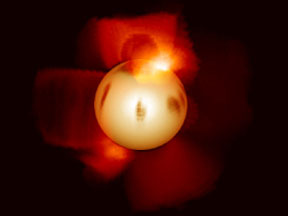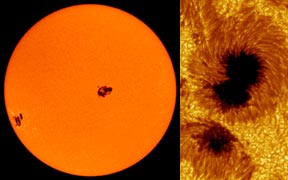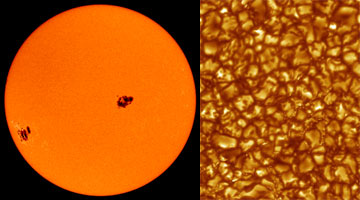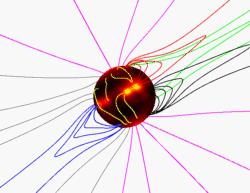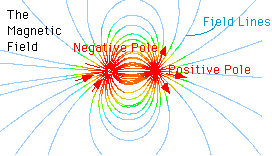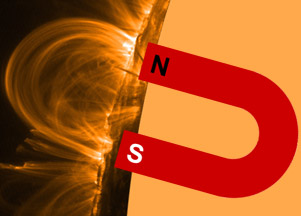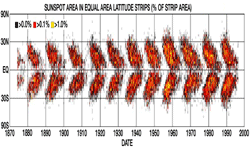Click on image for full size
Image courtesy A. Cameron, M. Jardine and K. Wood, University of St Andrews.
Starspots
In recent years astronomers have become able to detect "starspots" on distant stars! Like the sunspots that frequently dot the "surface" of the nearest star, our Sun, starspots are relatively cool, dark regions on the visible "surfaces" of some stars. Although stars are too far away for us to directly image, as can be done with the Sun, astronomers have developed techniques to indirectly "map" the surfaces of some stars, and have managed to detect starspots in the process.
Stellar evolution theories predict that our Sun spun faster and was more active when it was young. Sunspot formation is apparently a result of the tangling of the Sun's magnetic fields due to the Sun's rotation. Astronomers believe that a faster-spinning, younger Sun had more sunspots and was more active. Likewise, stellar astrophysicists think that young, rapidly-spinning stars (especially ones that are similar to our Sun in its youth) are likely to develop abundant crops of starspots. Recent observations seem to support these theories about starspots.
The Sun is roughly 5 billion years old and rotates once every 25 days. Most of the stars upon which starspots have been "observed" (we'll get into how that is done in a minute) are young and rotate rapidly. The star AB Doradus has rotational period of just 12.4 hours (it spins nearly 50 time faster than the Sun!) and is only 30 million years old. Another spotted star, EK Draconis, turns once every 2.7 days and is 100 million years old. A third star upon which starspots have been detected, kappa Ceti, is between 650 and 750 million years old and rotates once every 9.2 days. The powerful magnetic fields that generate starspots on young stars may be the remnants of the magnetic fields embedded in the protostellar clouds from which the stars condensed.
Certain types of binary star systems (double stars) appear to have spots on one or both of the stars. This is especially the case for binaries which orbit very close to each other, and may result from interactions between the two stars. The binary system VW Cephei is a remarkable case; spots cover some 66% of the surface area of one partner and 55% of the other, and both stars appear to have large spots at their poles.
Some stars have so many spots, or possibly a few very large ones, that they grow brighter and dimmer by as much as 20% as they rotate and their spotted sides come in and out of view as seen from Earth. One active red giant star, HD 12545, has a truly enormous starspot. The single spot covers 11% of the entire surface area of the giant star, which has a radius 11.4 times the size of our Sun. This gigantic elliptical spot has dimensions of about 12 by 20 solar radii and covers an area about 10,000 times greater than the largest sunspots observed on the Sun.
Stars are so far away that their images, even in the largest telescopes, are much too small for us to directly view starspots. How then do astronomers "observe" starspots? In the case of binary systems, astronomers make repeated observations of eclipses of one star by the other. As the amount of light varies as one star passes in front of the other, the scientists can infer the relative brightness of the hidden portion of the eclipsed star. Many, many repetitions of such eclipse observations eventually yield a rough map of the surface brightnesses of the two stars, which allows us to indirectly "see" the patterns of spots on the stars.
A different approach is required to observe spots on single stars. The "Doppler imaging" technique relies on the rapid rotation of young stars and the difference in the absorption spectrum of a cooler, darker sunspot as compared to unblemished regions of a star's photosphere to create a map of the star's surface. As the star spins it carries its spots towards and away from us, in and out of view (as they swing around to the far side of the star), producing minor fluctuations in the star's spectrum that enable scientists to map the starspot sizes and locations. A third technique, Zeeman-Doppler imaging, extends the Doppler imaging approach. The strong magnetic fields of starspots alter the polarization of light emitted from starspot regions, which result in variations in the stellar spectrum as the star rotates. Once again, careful observations of changes in this spectral signature as the star rotates, carrying starspots in and out of view, lead to maps of starspots on distant stars.
Just as the number and locations of sunspots vary over the course of the sunspot cycle, some astronomers are beginning to study similar variations in starspot counts and locations on certain stars. Some researchers have even managed to generate butterfly diagrams of the variations of starspot patterns over time for the star LQ Hydrae!


